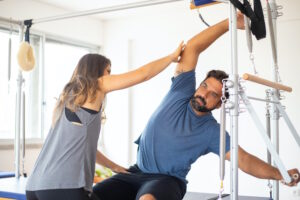
Proper posture and alignment are essential for optimal health, well-being, and movement efficiency. Unfortunately, many individuals struggle with poor posture due to sedentary lifestyles, muscular imbalances, and incorrect movement patterns. Pilates, especially when practiced with the aid of specialized equipment, can be a powerful tool for improving posture and alignment. Pilates equipment provides support, resistance, and targeted exercises that address postural imbalances, strengthen the core, and promote optimal alignment. In this article, we will explore how Pilates improves posture, provide tips for improving posture and alignment, discuss the benefits of using Pilates equipment, and identify other factors that contribute to improved posture and body alignment.
How does Pilates improve your posture? Pilates is a highly effective method for improving posture due to its focus on core strength, body awareness, and alignment. Pilates exercises target the deep stabilizing muscles of the core, including the abdominals, back, and pelvic floor. By strengthening these muscles, Pilates helps support the spine and pelvis in proper alignment, improving posture. The controlled and precise movements in Pilates promote muscle balance, flexibility, and body awareness, allowing individuals to correct postural imbalances and develop optimal alignment. Additionally, Pilates emphasizes proper breathing techniques, which can further enhance posture by encouraging proper engagement of the core muscles and relaxation of tense muscles.
How can I improve my posture and alignment? Improving posture and alignment requires a multifaceted approach that includes both physical and mindful practices. Here are some tips to help you improve your posture:
1. Core Strengthening: Focus on exercises that target the deep core muscles, such as Pilates, to improve core strength and stability.
2. Stretching: Incorporate stretching exercises to release tension in tight muscles and improve flexibility. Pay attention to areas commonly affected by poor posture, such as the chest, shoulders, and hips.
3. Body Awareness: Cultivate body awareness by practicing mindfulness and paying attention to your posture throughout the day. Make a conscious effort to sit and stand tall, keeping your shoulders relaxed and your spine lengthened.
4. Ergonomics: Ensure that your work and living environments are ergonomically set up to support good posture. Adjust your desk, chair, and computer screen to proper heights and positions.
5. Posture Exercises: Practice specific exercises that target postural muscles, such as scapular retractions, thoracic extensions, and hip stretches, to strengthen and lengthen muscles necessary for good posture.
Why use Pilates equipment? Pilates equipment provides unique advantages for improving posture and alignment. The equipment, such as the reformer, Cadillac, and Pilates chair, offers adjustable resistance and support, allowing individuals to perform exercises that target specific postural imbalances. The equipment assists in developing body awareness, proper muscle activation, and alignment. The reformer, for example, provides resistance and support to challenge core strength while promoting optimal alignment. The Cadillac allows for targeted exercises that improve postural alignment and mobility. Utilizing Pilates equipment adds variety, challenge, and precision to your practice, enhancing the benefits of Pilates for improving posture and alignment.
What can benefit and improve posture and body alignment? Aside from practicing Pilates and utilizing Pilates equipment, several other factors can contribute to improved posture and body alignment:
1. Regular Exercise: Engage in a variety of physical activities, including cardiovascular exercise, strength training, and flexibility training, to support overall muscular balance and alignment.
2. Mindfulness and Postural Habits: Be mindful of your posture throughout the day, correcting any slouching or rounding of the shoulders. Practice good postural habits when sitting, standing, and walking.
3. Ergonomic Awareness: Ensure that your work and living environments are ergonomically set up to support good posture. Use ergonomic chairs, supportive pillows, and proper footwear to minimize strain on your body.
4. Regular Stretching and Mobility Work: Incorporate regular stretching and mobility exercises into your routine to maintain flexibility and release tension in tight muscles.
5. Professional Guidance: Seek guidance from a qualified Pilates instructor, physical therapist, or posture specialist who can provide personalized exercises and guidance tailored to your specific postural needs.
In summary, Pilates, especially when practiced with the aid of equipment, is highly effective for improving posture and alignment. Pilates strengthens the core, promotes body awareness, and emphasizes proper alignment, resulting in improved posture. In addition to Pilates, other practices such as regular exercise, mindfulness, ergonomic awareness, and regular stretching can contribute to better posture and body alignment. Utilizing Pilates equipment adds support, resistance, and precision to your practice, enhancing the benefits of Pilates for improving posture and alignment. Incorporating these practices into your daily routine can lead to long-term improvements in posture, overall body alignment, and well-being.